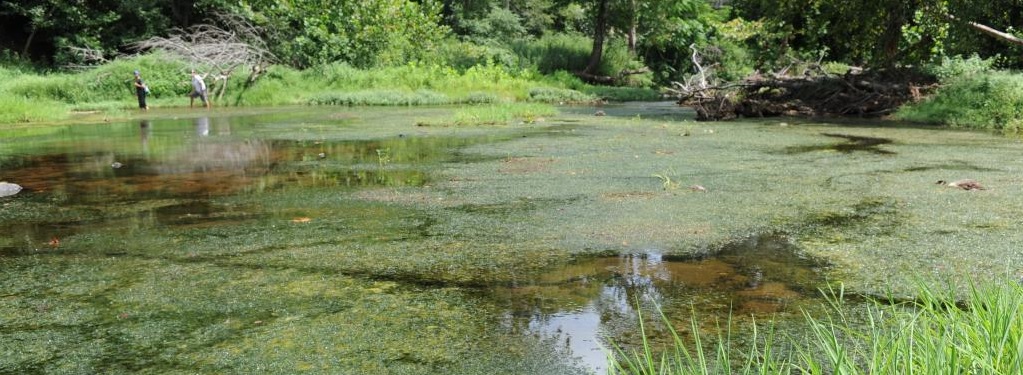
Using Herbicide to Decrease Presence of Invasive Hydrilla Plant Species
Released by Charlie Peek, ncparks.gov
A two year pilot project launched in 2015 to control hydrilla in the Eno River has reduced the amount and growth rate of the non-native, highly invasive weed, with little to no-long term effect on other plant life or river species, according to the Eno River Hydrilla Management Task Force.
Members of the multi-agency task force introduced the herbicide fluridone into a section of the waterway at Eno River State Park, located in Orange and Durham counties, last summer as a part of a two-year pilot project that would determine if herbicide treatment in a flowing river would be as effective as it has been in lakes elsewhere in the state.
Since then, scientists have been monitoring native animal and plant species in the river to make sure there is no significant injury to those non-target organisms caused by the weed management activities.
Hydrilla is a submersed (underwater) aquatic plant that can create nearly impenetrable mats of stems and leaves on the surface of lakes, rivers and other waterways. An invasive species from Asia, hydrilla impedes recreational use of waterways, crowds out native vegetation and can ultimately harm fish and other aquatic species. The plant can also clog intakes where rivers or reservoirs are used for drinking water supplies and irrigation.
Researchers monitoring the Eno River found that hydrilla density and the length of hydrilla shoots were noticeably reduced in treated areas. Meanwhile, a companion laboratory study indicated the herbicide at the concentrations used had no adverse effects on non-target species, including the most sensitive — freshwater mollusks, including the panhandle pebblesnail, a rare species in North Carolina.
Hydrilla was first discovered in the Eno River basin in the early 1990s in Lake Orange, which is located upstream of Hillsborough. In 2009, biologists confirmed hydrilla in another upstream reservoir, West Fork Eno Reservoir. The plant fragments easily and those fragmented sections can grow into new plants. The hydrilla at Eno River State Park likely came from fragments that floated down from upstream reservoirs. The NC Division of Water Resources is actively managing hydrilla in both reservoirs.
Members of the task force have surveyed the river over the last three years and detected hydrilla at different densities in 25 miles of the river. The most infested area was about 15 miles of river from the NC Highway 70 Bridge in Hillsborough to Guess Road in Durham.
Task force members are working on ways to continue the treatment in 2016 to ensure that the project will be successful.
The Eno River Hydrilla Management Task Force involves partners from Durham and Orange Counties, the City of Durham, the Town of Hillsborough, the City of Raleigh, N.C. Division of Parks and Recreation, the NC Wildlife Resources Commission, the NC Division of Water Resources. Members include land managers, researchers and agency administrators.
For more information on the Task Force or the Eno River Hydrilla Management Project, visit the nc-ipc.weebly.com/eno-river-hydrilla-project.html.
Ed. Note: A little more fluridone information is available on wikipedia.org.


